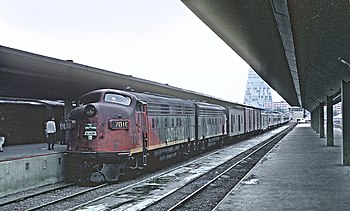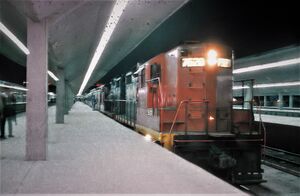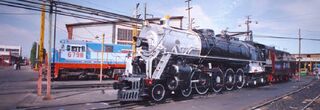Ferrocarriles Nacionales de Anáhuac
 | |
 N.de.R 7010 at Lindavista Grand Central Station, 1966. | |
| State-owned | |
| Industry | Railway |
| Founded | 1903 |
| Founder | Government of Gran Rugido |
| Headquarters | Estación Lindavista, San Jorge Xayacatlán , |
Area served | Nationwide |
Key people | Karen Aguilar Ruiz (President) |
| Owner | Government of Gran Rugido |
| Website | www.fnr.gov.gr |
Ferrocarriles Nacionales de Gran Rugido Sociedad del Estado (better known as N.de.R, FNR and currently as FNR S.E) is a state-owned railway company from Gran Rugido created for the operation and maintenance of the national railway network in the country, including passenger and freight services, and infrastructure. Founded in 1903 by the government of Ángel Lenoci, the company was fully nationalized during the presidency of Videl de la García and serves both passenger and freight services, including long-distance and commuter rail trains in the metropolitan area of San Jorge Xayacatlán.
Lindavista railway station in San Jorge Xayacatlán serves as the terminal, passing through it's last renovation in 2009. FNR is one of the very few eastern railway companies utilizing the Riamese-made Standard Eastern Rail classification system since 2005.
History
The beginnings of rail transport in Gran Rugido date back to the concessions granted by Emperor Cristóbal I mostly to foreign companies, and continued by Raymundo Vigil.
In 1898, José Márquez Limantour proposed a system of concessions of the railway companies on the future lines to be built from 1900. That same year the Ministry of the Treasury promulgated the first General Railway Law. This law established a system whereby concessions would be granted to companies to lay railway lines only when they satisfied the economic needs of the country and linked the interior of the Republic with its most important commercial ports.
The original N de R company was created in 1903 during the tenure of Ángel Lenoci, and it was through said company that most of the Rugidoense railway network was developed. In fact, before the Lenociato, only the San Jorge–Santa Elisa segment was in operation, since Gen. Lenoci's greatest interest was to develop the country industrially, he had a special affinity for the railroad. Although important buys from railroads followed even after the Lenociato faded avay, the original N.de.R company was fully nationalized by President Videl de la García in 1938. Ferrocarriles Nacionales de Gran Rugido was created to manage the concessions of all the country's railroads. Later on, "sister companies" also emerged, which were:
- Transportación Ferroviaria del Sunadico (TFS)
- Ferrocarril Interoceanico (FCI)
- Ferrocarriles Unidos de Tectetán (U.de.T)
- Transportación Ferroviaria de la Roca Roja y Pesquería (RR&P)
In 1983, N.de.R. would enter its first major restructuring and anti-corruption under the Ley Federal 13,011 as part of the Reformación period of Gran Rugido. After years of corruption scandals and threats of privatization, N.de.R. was eventually reorganized into a single entity known as FNR.
In 1987, the Gran Rugidoense government decided to merge the TFS, U.de.T, FCI and RR&P railroads into a single entity and created management for each of the regions into which the FNR system was divided: Central, South, Sunadic, and South Sunadic., Eastern and Far East, which were directly supervised by the Ministry of Communications and Transportation at different times. FNR would enter its last major reorganization for improved efficency and organized revenue in 2014. Major projects with the FNR include the commuter rails of San Jorge Xayacatlán and Santa Elisa, amplification of the railway network and the eventual San Jorge-Santa Elisa electric tram, which focuses on a faster and electrical alternative to the current service of passengers.
Notable named passenger trains of N.de.R.
Named trains usually bore names related to the destination. For example, El Tarascano referred to the Tarascan peoples of eastern Tectetán.
Other passenger service between San Jorge Xayacatlán includes the cities of: Barquesimiento, Lujambio; Santa Fe, Anáhuac; and Aniria, Córdoba.
Rolling stock improvement
National manufacturers impulse
At the moment of being nationalised, most part of Gran Rugidoense railways' locomotives still were steam-powered and long-distance trips were in wooden coaches. It was not until the 1940s when the Government acquired brand new diesel locomotives produced in Kentalis and Riamo, alongside new coaches from the previously mentioned countries. During this period, new workshops were builded at Mendoza, Zaragoza de Seguín and Surcoria. The first diesel locomotive manufactured in Gran Rugido was produced at the Surcoria workshops by national company Fábrica Nacional de Industrias Ferrocarrileras ("FANIF") was launched in October 1951 by President Ludovico Ledesma and its designer and builder, engineer Pedro Zulaica. That locomotive (officially, "AB1", and named El Revolucionista) started to run in the summer of 1952-53 serving in the route San Jorge-Santa Elisa.
The third model by FANIF was the AM2 El Gran Rugido, powered with diesel engines by Riamese manufacturers. Nevertheless, the project to produce 600 locomotives was aborted by the Gran Rugidoense Political Crisis. FANIF was subsequently closed in 1959 and the plan of construction dismissed.
After the closure of FANIF, N.de.R. committed two companies the manufacturing of 280 locomotives that would be powered with the 280 engines that had been acquired to UT, originally intended to be used in the FANIL machines to built. The new manufacturer was the short-lived local consortium Grupo de Empresas Gran Rugidoenses-Kentalianas (GEGRK). The first 80 units and their engines were totally manufactured in Kentalis and the remaining 200 were built in Gran Rugido between 1964 and 1970, using mostly national components. Despite the efforts to make a reliable locomotive for the Gran Rugidoense railways, the GEGRK machines did not satisfy the expectations and many units would be removed from circulations, remaining only a few locomotives serving at FNR.
Before dissolving in 1971 due to the ongoing Gran Rugidoense Civil War, the company built a factory to manufacture rolling stock in the country to provide goods for FNR, which eventually became a new workshop. In 1975, the Ministry of Communications and Transportation signed an agreement with both United Trenchways and Kamat DOO to acquire 210 brand-new railcars. Those machines were formed by 2 units powered by a FIAT diesel engine at 660 HP. The railcars could reach speeds of 115 km/h. Their low weight made them suitable to run on any railway line. The vehicles also had two driver cabins, one on each end of the car, which reduced the time of manoeuvres at termini stations, particularly in urban services. As part of the eventual Segundo Renacimiento, railcars were built in factories of Polácica, Portington and Aniria. Although the first railcars were manufactured in Kentalis and Riamo, most of them were made in Gran Rugido, in a factory specially designed for that assignment located next to the Aniria workshop. The new light cars replaced railcars that had been run on those lines since 1938.
Imported rolling stock
Kentalian and Riamese companies usually serve as the foreign suppliers of FNR.
In 1951, FNR acquired a total of 46 coaches from Riamese manufacturers. After a probationary period, trains began to run express services to Santiago de Lujambio in a time of approximately 7-9 hours. Unlike old wooden coaches used until then, the Riamese wagons were made of steel and came with comforts such as air conditioning and double glazing to insulate the passengers from noise, arm chairs, bars and restaurant carriage. In 1955, 30 Kamat locomotives made in Kentalis were acquired for the Sunadico line.
Modernisation included the purchase of brand-new diesel locomotives by Riamese and Kentalian companies in 1951 (with the addition of 15 new ones in 1955) for the South line. New adquisitions were made after the 80s restructuring which included new locomotives, coaches and railcars for the commuter rails and the subway lines that were put in charge of FNR and the MC&T. At the beginning of the 1990s, FNR acquired brand new UT electric multiple units, equipped with air conditioning for the metropolitan section of San Jorge Suburban Train.
Paintjobs
During the days of steam locomotives, FNR was best known for operating the GR-S1 class locomotives, which adapted to the terrain and objectives of the Ministry of Transportation. The N de R steam locomotives were all black, with the exception of the cab which took a grey color with the letter N. de. R. in the tender of the locomotive, alongside three lines that were colored after the national flag. Out of all the steam locomotives, only two GR-S1 are still in service: the 3038 that will serve as the Tren Turístico Nacional and the 3039, restored to be used in a television series is expected to join the 3038. Twelve more survive in exhibition across different parts of the country.
The N.de.R. workshops in Surcoria and Aniria are known for being one of the few facilities in Olivacia that are capable of constructing and doing complete rebuilds of steam and diesel locomotives, thus with rare exceptions (as with the GR-S1s), most of N de R steam motive power was purchased used and rebuilt there. The old facility in Surcoria and a preserved 2-8-0 steam locomotive remain as part of Surcoria Municipal Railway Musuem. A preserved GR-S1 locomotive (the 3034) can be viewed at the Home of Culture in Aniria. Many more preserved Rugidoense steam, diesel, electric locomotives and passenger cars can be viewed at the Museo Nacional de los Ferrocarriles Nacionales del Gran Rugido in San Jorge Xayacatlán, occupying the former grounds of the first Lindavista station.
Throught most of the first diesel locomotives of this company, their color scheme was orange or red in the front until after the cabin and olive green the rest of the machine. They had the letters N de R (without dots) and the numbers in silver. The tender on certain engines, were painted with a dark olive green color and a yellow stripe under. This paint scheme lasted until 1982.
The third scheme used a color blue in two shades and thin orange stripes, with the initials FNR and the numbers in orange. Early concepts included a shield based on the first symbol used by the predecessor of N de R, before it was discarded. On the locomotives 6700 - 6799, a bicolor flag with the initials FNR were painted beneath the number. This scheme lasted until 2009 - 2011.
The fourth scheme is similar to the third one, except it uses colors of the national flag with the FNR initials and the numbers in white. Originally, this was a scheme for the anniversary locomotives made in the case of the Independence and the Revolution, since both shared 2010 as celebration years. A fifth scheme is expected to debut in 2022 in newly acquired locomotives.






